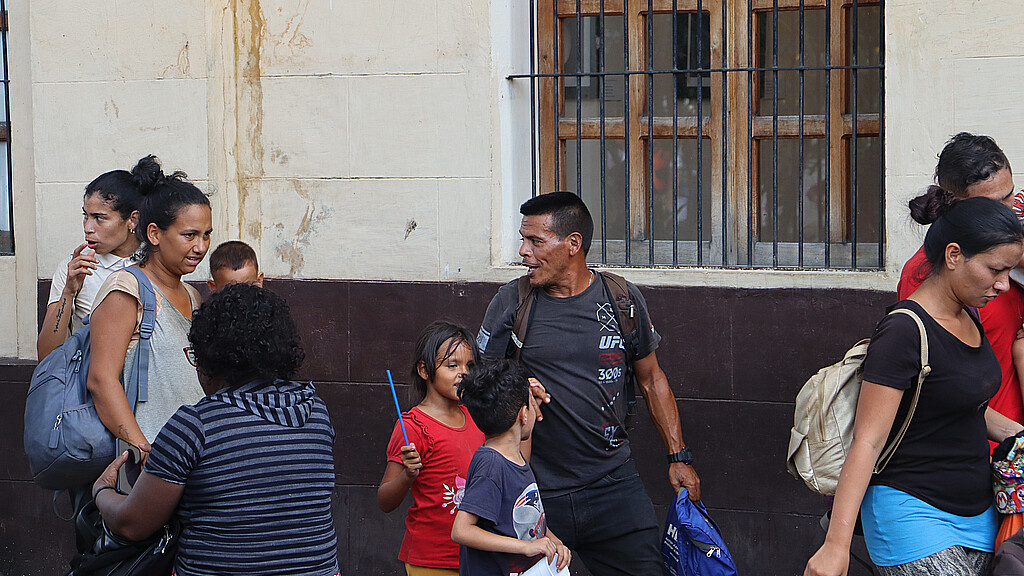Immigration
Shelters at Mexico's southern border overwhelmed as migrant housing costs triple amid national inflation
Inflation and the migratory flow caused the cost of keeping a migrant stranded on Mexico's southern border to triple

July 11, 2024 3:54am
Updated: July 11, 2024 9:20am
Inflation and increased migratory flow are causing the cost of housing migrants at Mexico's southern border to triple, according to a calculation by the Tapachula branch of the National Chamber of Commerce for Services and Tourism (CANACO) and reported by the EFE Spanish language News Agency on Wednesday.
CANACO are local chambers of commerce in Mexico that are represented on a national level by the National Confederation of the Chambers of Commerce, which reports concerns to the Mexican federal government.
EFE reported that citizen groups are absorbing this expense in the face of the government's inaction to confront the migration crisis that has taken place at the country's border points for several months.
Inflation and the Consumer Price Index in Mexico
The cost to support a migrant now costs about 1,200 pesos a day (about $66.6), 300% of the 400 pesos ($22.2) it cost before in 2016 before the migrant caravans increased, according to Mexican lawyer Jorge Zúñiga Rodríguez, who serves as CANACO’S president in Tapachula, a town located on the Mexico’s southern border with Guatemala.
“It is basically the cost of lodging,” he explained. “Even if it is on a migratory basis, there are costs: food, health issues, transportation … and in the case of municipalities, services have a cost,” the official said.
The increase stems from two issues that are taking place contemporaneously, according to Zúñiga: inflation and migration increases.
Mexico’s inflation rose to 4.98% in June, reaching its highest levels so far this year, according to a report released Tuesday by the National Institute of Statistics and Geography (INEGI). That rate is an increase from 4.69% in May and above market forecasts of 4.84%.
According to INEGI, upward pressure came from several Consumer Price Index (CPI) categories, including food and non-alcoholic beverages, hotels and restaurants, miscellaneous goods and services, and transportation costs.
One of the most significant increases was a spike in housing and utilities 3.76% to from 4.52%, the NIM reported.
“It was the highest reading in a year, driven by the post-election slump in the peso due to heightened political uncertainty,” according to the online publication, Trading Economics.
Skyrocketing migration at Mexico's southern border
Coupled with these price increases, irregular migration to Mexico rose nearly 650%, showing a surge of almost 1.4 million from January to May, according to a June report published by Mexico’s National Migration Institute (INM).
The situation has had a devastating impact on local civil organizations in Tapachula, which have told journalists and international organizations they are struggling to survive. The town is located in the southern Mexican border state of Chiapas.
Lorenza Reyes Nuñez, director of Todo Por Él, one of the largest shelters on the border, told EFE her shelter is spending about 1,000 pesos a day (about $56 USD) day on just one meal for migrants.
The activist told the press that Todo Por Él “lives off the help of good-hearted Mexican people,” who make donations to the shelter center.
On April 30, EFE interviewed Reyes about the state of affairs in Tapachula as she tried to lift the spirits of many migrant children who were celebrating Children’s Day from area transit shelters.
“Here, they are even given clothes and shoes,” Reyes said in her recent interview with EFE, adding that the number of migrants there now is overwhelming for citizen groups on the southern border.
“There are too many people, sometimes it stresses me out, but God closes one door and opens another, faith is the last thing that is lost with all this bunch of people,” she added.
In an earlier Oct. 1, 2023 interview with EFE, parts of which were republished in English by The Yucatan Times, Reyes said the migration flow at the Mexican southern border was overwhelming the Tapachula area.
“In supermarkets, eggs, bread, rice, beans, and sugar have already become scarce, and the price of sugar has doubled,” she told the Spanish language news agency last year. “It’s worrisome for both Mexicans and migrants alike,” the committed aid volunteer told EFE.
A continuing crisis
During that October 2023 interview Reyes said that Mexican authorities “are not doing anything” to stop the migratory flow, leaving all the work to the Mexican Commission for Refugee Assistance (COMAR), which was overwhelmed by the daily arrival of thousands of foreigners.
The commission oversees refuge, asylum, and complementary protection for asylum seekers in Mexico, and reports to the Undersecretary for Human Rights, Population, and Migration, and operates under the supervision of the Ministry of Interior, according to the Global Task Force on Third Country Education Pathways.
“Their work does not end only with the recognition of refugee status; it goes beyond that and also focuses on local integration, including access to higher education, which is the topic that is being discussed today. Also, access to documentation, health, and work permits, among others. These topics are understood as vital so refugees can be adequately integrated into Mexico,” the task force’s website explains.
In her 2023 interview with EFE, Reyes said that while Tapachula was accustomed to receiving migrants from around the world “in the city’s history, there has never been as many migrants as this year.”
The 2023 report also indicated even at that time that the situation at Mexico’s southern border was a result of the “unprecedented increase in migrant populations in Central America and Mexico,” according to data from the International Organization for Migration (IOM), which is leading migration international organization of the United Nations.
It said that there were so many migrants seeking asylum at Mexico’s southern border that there was an unprecedented number of undocumented individuals sleeping on the streets and trying to secure appointments at the offices of the National Migration Institute (INM).
The 2023 EFE report also indicated that another area shelter, the Todo Por Ellos shelter, was receiving around 6,000 migrants monthly, and another (Belén), located at the city’s entrance, was housing about 500 migrants, tripling its usual capacity.
Gerber Bermúdez, the administrator of the Jesus el Buen Pastor shelter told EFE in October that they were running low on food and that hundreds of people sleeping outside because they no longer had room to accommodate them.











